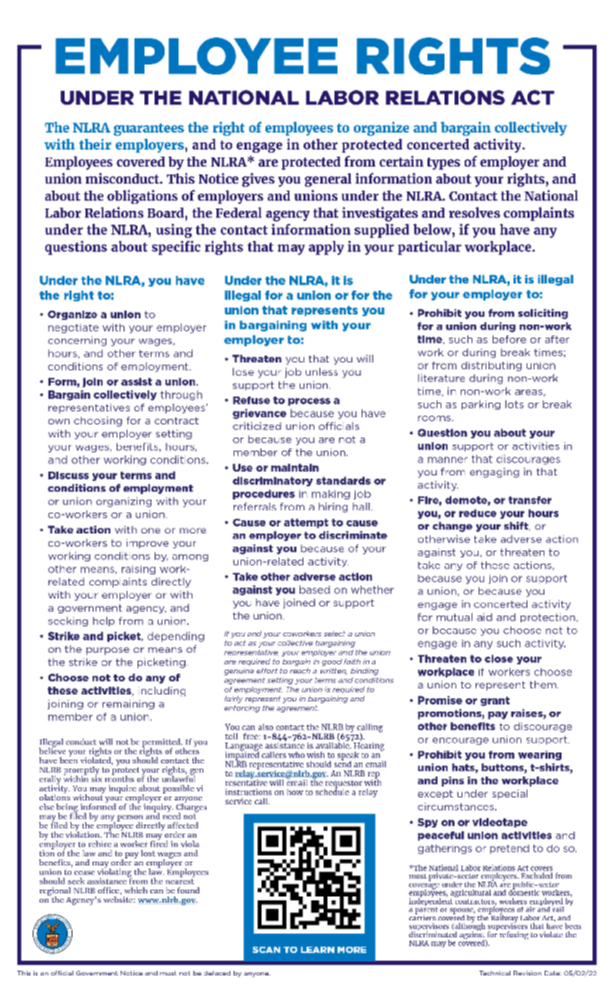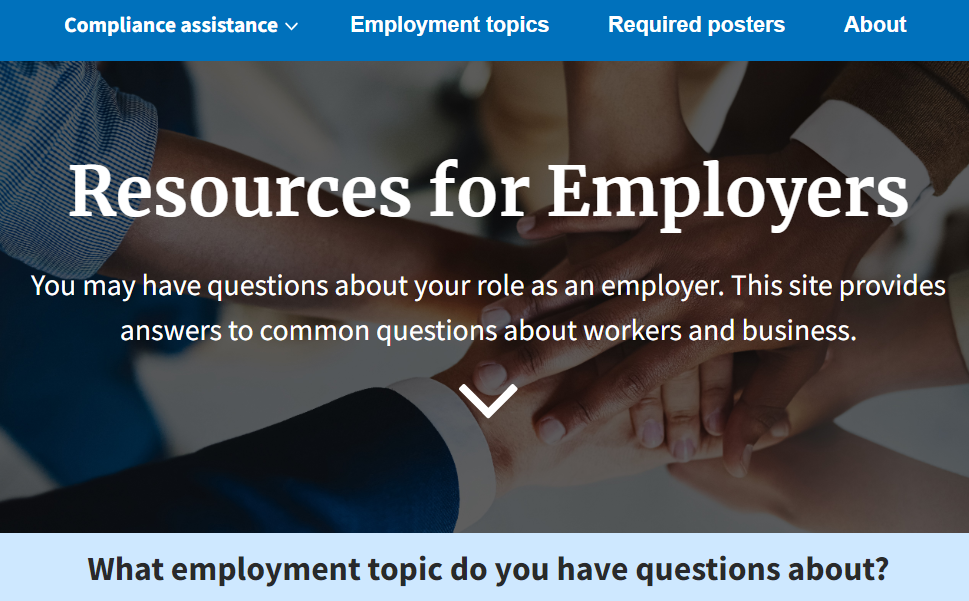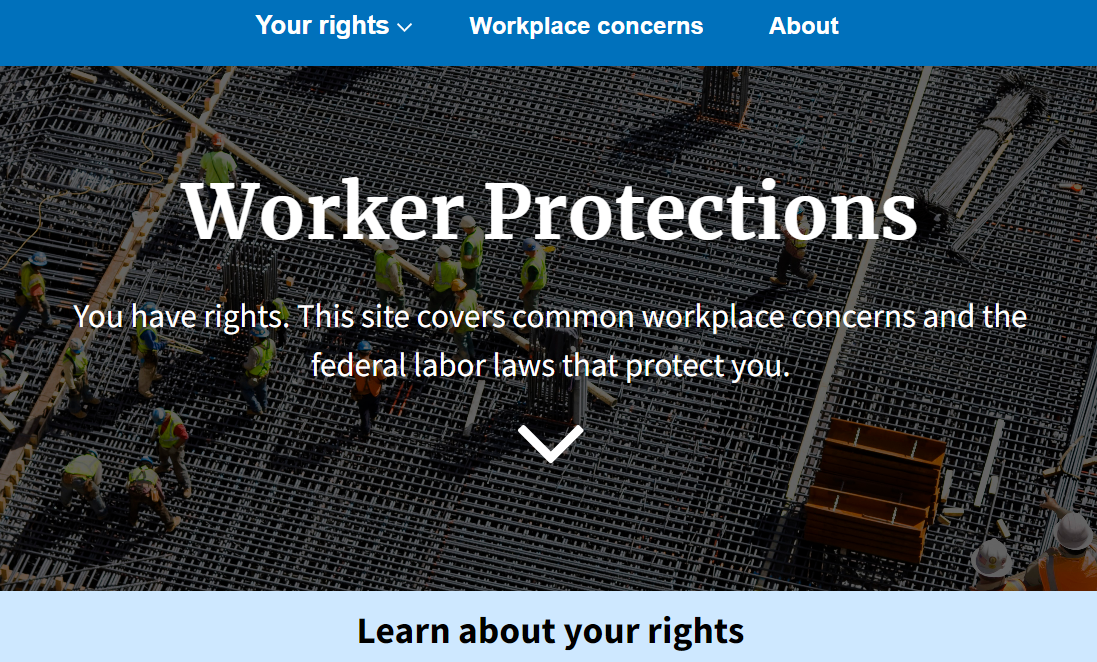One of the best ways for workers to have a voice and power in American workplaces is to organize a union. The legal right to organize and bargain collectively over wages, hours, and terms and conditions of employment, and the resulting legally binding union contract, empowers workers and strengthens their protections in the workplace. Unionization provides other advantages – and not just for workers. Employers, communities, and local economies can benefit as well.
Are you looking for information on unions and collective bargaining? There are resources at the Department of Labor available for you. The Worker Organizing Resource and Knowledge (WORK) Center is a one-stop shop for workers, employers, unions, government agencies, students, and anyone interested in unions and collective bargaining. Additionally, we invite you to explore resources from the Office of Labor-Management Standards on empowering workers:
The Labor-Management Reporting and Disclosure Act of 1959
Employee Rights Under the NLRA
Persuader and Surveillance Information
Collective Bargaining Agreements
What Unions Do for Workers and the Economy
The Labor-Management Reporting and Disclosure Act of 1959
The Labor-Management Reporting and Disclosure Act (LMRDA) is a law in service of the national policy, embodied in the LMRDA itself, to “protect employees' rights to organize, choose their own representatives, bargain collectively, and otherwise engage in concerted activities for their mutual aid or protection” in the private sector. It grants certain rights to union members and protects their interests by promoting democratic procedures within labor organizations and financial transparency of unions generally and employers and their consultants when they inject themselves into worker organizing campaigns. Among its many protections, the LMRDA establishes:
- a Bill of Rights for union members
- reporting requirements for labor organizations, union officers and employees, employers, labor-relations consultants, and surety companies
- standards for the regular election of union officers
- safeguards for protecting labor organization funds and assets
The Secretary of Labor enforces certain provisions of the LMRDA and has delegated that authority to the Office of Labor-Management Standards. OLMS enforces those provisions through the lens of the act’s stated national policy. Other provisions of the LMRDA may only be enforced by union members through a private suit in a federal district court. OLMS also administers similar protections for federal-sector unions.
Know Your Rights Workplace Poster Are you a federal contractor or subcontractor employer? If you are, you are required by Executive Order 13496 to post an Employee Rights Under the NLRA poster to inform your employees of their rights under the NLRA.
OLMS fulfills an important role in helping ensure workers and employers are made aware of these labor rights and understand them through its Employee Rights Under the NLRA posters. For information on why federal contractors are required to post the poster, OLMS’s responsibility for making the poster available, and free electronic copies of the poster in 15 languages, please visit this page.
Employee Rights Under the National Labor Relations Act

Persuader and Surveillance Information
Did you know that the LMRDA requires employers and their labor relations consultants to file reports with OLMS when they engage in certain persuader activities or employee surveillance activities in connection with union organizing campaigns or other labor disputes or when they make expenditures with an object of violating employees’ rights under the NLRA? Examples of these activities include an employer paying outside consultants to persuade workers to vote against the formation of a union or an employer, in connection with a labor dispute, using computer software, surveillance cameras, or audio capture devices to record organizers while they explain what the role of a union would be to workers. These reports (Forms LM-10, LM-20, or LM-21) are available to view in our Online Public Disclosure Room. Access to these reports helps bring transparency to employer agreements and expenditures to persuade their workers concerning their organizing and collective bargaining rights, as well as to surveil workers and unions involved in a labor dispute.
Are you aware of an employer or employer consultant who should file a report with OLMS but has not? We have a Persuader Reporting Tip Line as well as Employer and Consultant Reporting resources to make sure that employers and consultants remain in compliance.
Collective Bargaining Agreements
Are you interested in learning more about collective bargaining? Are you curious about what topics employer and union negotiators discuss and memorialize into contracts, which are known as collective bargaining agreements, or CBAs for short? Or perhaps you are looking for a specific collective bargaining agreement? Maybe you are an employer or union negotiating a first contract and looking for examples?
The OLMS Online Public Disclosure Room contains more than 3,500 negotiated agreements from the private and public sectors. Employers and unions are invited to submit their CBAs to OLMS for inclusion in the database.
For more information, email olms-public@dol.gov or call 202-693-0123.
What Unions Do for Workers and the Economy
OLMS promotes labor-management transparency, helps ensure that workers have a voice in the workplace through democratic, financially secure labor unions, and highlights the important role unions play in the American economy.
Labor unions:
➡️ improve wages and working conditions for all workers,
➡️ help reduce wage gaps for women workers and workers of color,
➡️ help develop better job safety protections and better paid leave benefits for their members,
➡️ help employees avoid unfair treatment when they choose to exercise their rights
The Union Advantage provides data-driven analysis and information showing how organized labor benefits workers and employers, alike.
Research shows states with greater union density provide greater social safety-net protections through state legislation and regulation than those with lower union density. By and large, workers, whether they are working under union-negotiated collective bargaining agreements or not, benefit from organized labor.
Want to learn more about unions and how they empower workers? Subscribe to receive our latest updates.
Last Updated: 3-23-2023



